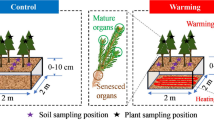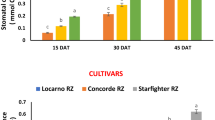Abstract
The temperature dependences of net photosynthetic rate (P N), stomatal conductance (g s), transpiration rate (E) and dark respiration (R D) of four neem (Azadirachta indica A. Juss) provenances of 11 years old were measured in three seasons of 2006 in the dry-hot valley area of southwest China under field conditions. The results indicated that P N of four neem provenances showed clear parabolic responses with the increase of temperature. The optimum temperature of P N was around 25°C in initiation stage and 30°C in prosperous stage except for neem originating from Jodhpur (MA) provenance which was very close to the mean daily temperature of the preceding week while it was around 27°C (MA provenance excepted) in last stage which was rather close to the mean daily maximum temperature of the preceding week. The optimum temperature for P N of MA provenance was about 2–4°C higher than that of the other three neem provenances in prosperous stage and last stage. According to the fitted parameters of photosynthetic temperature response curves, the photosynthetic performance in prosperous stage was more sensitive to temperature changes than that in initiation stage and last stage while the photosynthetic performance of neem originating from MA provenance was less sensitive to temperatures than that of neem originating from Kalyani, New Delhi and Kulapachta provenances in each growing stage. Furthermore, the temperature ranges for P N of MA provenance were much wider than those of the remaining provenances in each growing stage. These differences in photosynthetic temperature acclimation between neem provenances not only reflected temperature regime of native habitats of these provenances but suggested that MA provenance could be more tolerant to extreme temperatures compared with the remaining provenances. The temperature response curves of g s and E were generally similar in form in the same growing stage for all neem provenances; however, shape of the response curves in initiation stage and last stage was similar to parabolic curve while that in prosperous stage was similar to linear relation. The temperature for maximum g s and E in initiation stage was close to the optimum temperature of P N, but the maximum g s reached at much lower temperature than P N and E in last stage. The response of R D to temperature increased exponentially with temperature; however, there were obvious differences in different growing stages. R D in initiation stage was markedly higher than that in prosperous stage and last stage at a given temperature for four neem provenances. These results suggested that four neem provenances can acclimate to their growing environment through changed photosynthetic ecophysiological responses in course of subjecting to seasonal variation of temperature.



Similar content being viewed by others
Abbreviations
- P N :
-
Net photosynthetic rate
- g s :
-
Stomatal conductance
- E :
-
Transpiration rate
- R D :
-
Dark respiration rate
- KA:
-
Kalyani
- KU:
-
Kulapachta
- MA:
-
Jodhpur
- ND:
-
New Delhi
- VPD:
-
Vapour pressure deficit
- PPFD:
-
Photosynthetic photon flux density
- T opt :
-
Optimal temperature
- P N opt :
-
The net photosynthetic rate at optimal temperature
- P:
-
Provenance treatment
- G:
-
Growing stage treatment
- T:
-
Temperature treatment
References
Aphalo PJ, Jarvis PG (1991) Do stomata respond to relative humidity? Plant Cell Environ 14:127–132
Atkin OK, Evans JR, Siebke K (1998) Relationship between the inhibition of leaf respiration by light and enhancement of leaf dark respiration following light treatment. Aust J Plant Physiol 25:437–443
Atkin OK, Scheurwater I, Pons TL (2006) High thermal acclimation potential of both photosynthesis and respiration in two lowland Plantago species in contrast to an alpine congeneric. Glob Change Biol 12:500–515
Ball JT, Woodrow IE, Berry JA (1987) A model predicting stomatal conductance and its contribution to the control of photosynthesis under different environmental conditions. In: Binggins LJ (ed) Progress in photosynthesis research. Martinus Nijhoff Publishers, The Netherlands
Battaglia M, Beadle C, Loughhead S (1996) Photosynthetic temperature responses of Eucalyptus globulus and Eucalyptus nitens. Tree Physiol 16:81–89
Berry J, Björkman O (1980) Photosynthetic response and adaptation to temperature in higher plants. Annu Rev Plant Physiol 31:491–543
Bidwell RGS (1979) Plant physiology. MacMillan Publishing Co., Inc, New York
Bolstad PV, Reich P, Lee T (2003) Rapid temperature acclimation of leaf respiration rates in Quercus alba and Quercus rubra. Tree Physiol 23:969–976
Bunce JA (2000) Acclimation of photosynthesis to temperature in eight cool and warm climate herbaceous C3 species: temperature dependence of parameters of a biochemical photosynthesis model. Photosynth Res 63:59–67
Ferrar PJ, Slatyer RO, Vranjic JA (1989) Photosynthetic temperature acclimation in Eucalyptus species from diverse habitats, and a comparison with Nerium oleander. Aust J Plant Physiol 16:199–217
Hikosaka K, Ishikawa K, Borjigidai A, Muller O, Onoda Y (2006) Temperature acclimation of photosynthesis: mechanisms involved in the changes in temperature dependence of photosynthetic rate. J Exp Bot 57:291–302
Juriik TW, Briggs GM, Gates DM (1988) Springtime recovery of photosynthetic activity of white pine in Michigan. Can J Bot 66:138–141
Kattge J, Knorr W (2007) Temperature acclimation in a biochemical model of photosynthesis: a reanalysis of data from 36 species. Plant Cell Environ 30:1176–1190
Ketkar AY, Ketkar CM (1995) Medicinal uses including pharmacology in Asia. In: Schmutterer H (ed) The neem tree—source of unique natural products for integrated pest management, medicine, industry and other purposes. VCH Publishers Inc., New York
Koul O, Isman MB, Ketkar CM (1990) Properties and uses of neem, Azadirachta indica. Can J Bot 68:1–11
Kozlowski TT, Kramer PJ, Pallardy SG (1991) The physiological ecology of woody plants. Academic Press, San Diego
Lange OL (1975) Plant water relationships. Progr Bot/Fortschr Bot 37:78–97
Leuning R (1995) A critical appraisal of a combined stomatal-photosynthesis model for C3 plants. Plant Cell Environ 18:339–355
Mason N, Hughes P, McMullan R, Houghton JT (2001) Vegetation growth and the carbon balance. In: Introduction to environmental physics: planet Earth, life and climate. Taylor & Francis group, London
Medlyn BE, Dreyer E, Ellsworth D, Forstreuter M, Harley PC, Kirschbaum MUF et al (2002) Temperature response of parameters of a biochemically based model of photosynthesis. II. A review of experimental data. Plant Cell Environ 25:1167–1179
Onoda Y, Hikosaka K, Hirose T (2005a) Seasonal change in the balance between capacities of RuBP carboxylation and RuBP regeneration affects CO2 response of photosynthesis in Polygonum cuspidatum. J Exp Bot 56:755–763
Onoda Y, Hikosaka K, Hirose T (2005b) The balance between RuBP carboxylation and RuBP regeneration: a mechanism underlying the interspecific variation in acclimation of photosynthesis to seasonal change in temperature. Funct Plant Biol 32:903–910
Pearcy RW (1978) Acclimation of photosynthetic and respiratory CO2 exchange to growth temperature in Atriplex lentiformis (Torr.) Wats. Plant Physiol 59:484–486
Peng XM, Lai YQ, Zhang YP (2002) Study on the growth Pattern of the Azadirachta indica young plantation. For Res 15:469–473 (in China)
Raghavendra AS, Padmasree K (2003) Beneficial interactions of mitochondrial metabolism with photosynthetic carbon assimilation. Trends Plant Sci 11:546–553
Read J (1990) Some effects of acclimation temperature on net photosynthesis in some extra-tropical Australasian Nothofagus species. J Ecol 78:100–112
Read J, Busby JR (1990) Comparative responses to temperature of the major canopy species of Tasmanian cool temperate rainforest and their ecological significance. II. Net photosynthesis and climate analysis. Aust J Bot 38:185–205
Ribeiro RV, Machado EC, Oliveira RF (2004) Growth and leaf-temperature effects on photosynthesis of sweet orange seedlings infected with Xylella fastidiosa. Plant Pathol 53:334–340
Sage RF, Kubien DS (2007) The temperature response of C3 and C4 photosynthesis. Plant Cell Environ 30:1086–1106
Sall T, Pettersson P (1994) A model of photosynthetic acclimation as a special case of reaction norms. J Theor Biol 166:1–8
Shpak ED, McAbee JM, Pillitteri LJ, Torii KU (2005) Stomatal patterning and differentiation by synergistic interactions of receptor kinases. Science 309(5732):290–293
Slatyer RO, Morrow PA (1977) Altitudinal variation in the photosynthetic characteristics of snow gum, Eucalyptus pauciflora Sieb. ex Spreng. I. Seasonal changes under field conditions in the snowy mountains area of south-eastern. Aust J Bot 25:1–10
Strain BR, Higginbotham KO, Mulroy JC (1976) Temperature preconditioning and photosynthetic capacity of Pinus taeda L. Photosynthetica 10:47–53
Tewari DN (1992) Monograph on neem (Azadirachta indica A. Juss.). International Book Distributors, Dehradun
The Board on Science and Technology for International Development, National Research Council (1992) Neem: a tree for solving global problems. National Academy Press, Washington
Warren CR, Dreyer E (2006) Temperature response of photosynthesis and internal conductance to CO2: results from two independent approaches. J Exp Bot 57:3057–3067
Yamasaki T, Yamakawa T, Yamane Y, Koike H, Satoh K, Katoh S (2002) Temperature acclimation of photosynthesis and related changes in photosystem II electron transport in winter wheat. Plant Physiol 128:1087–1097
Yamori W, Nokuchi K, Terashima I (2005) Temperature acclimation of photosynthesis in spinach leaves: analyses of photosynthetic components and temperature dependencies of photosynthetic partial reactions. Plant Cell Environ 28:536–547
Zheng YX, Wu JC, Cao FL, Zhang YP (2010) Effects of water stress on photosynthetic activity, dry mass partitioning and some associated metabolic changes in four provenances of neem (Azadirachta indica A. Juss). Photosynthetica 48:361–369
Acknowledgments
We are very sincerely grateful to the anonymous reviewers for their valuable suggestions and comments. This work was supported by the project of National Science & Technology (2012BAD21B004).
Author information
Authors and Affiliations
Corresponding author
Additional information
Communicated by M. Buckeridge.
Rights and permissions
About this article
Cite this article
Zheng, Y.X., Wu, J.C. & Zhang, Y.P. Photosynthetic temperature responses of four neem (Azadirachta indica A. Juss) provenances in the dry-hot valley area of China. Trees 26, 929–937 (2012). https://doi.org/10.1007/s00468-011-0670-7
Received:
Revised:
Accepted:
Published:
Issue Date:
DOI: https://doi.org/10.1007/s00468-011-0670-7




